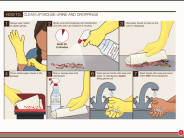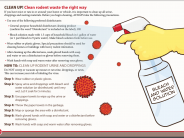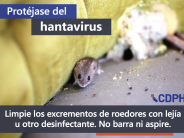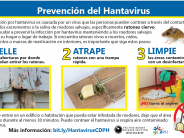Hantavirus
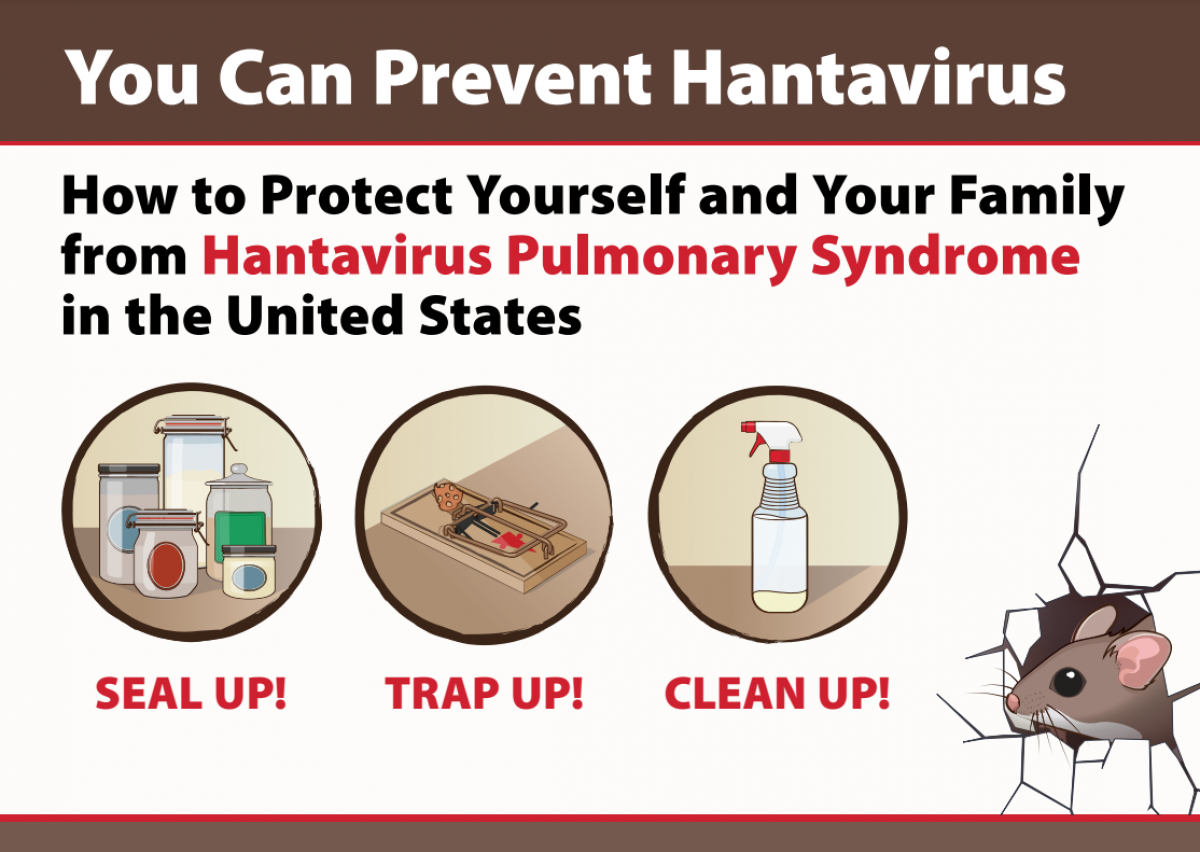
Key Points:
- Hantavirus is uncommon, but extremely serious and can be fatal
- Mono County averages just under 1 Hantavirus case per year
- Getting rid of mice and their droppings (poop) is the most effective way of preventing Hantavirus
- Safe clean up and disposal of mouse droppings can be accomplished safely and effectively if you take the proper steps
What is Hantavirus?
Hantavirus spreads through urine, droppings (poop), or saliva of mice. In California, Hantavirus is carried by deer mice specifically, which are common in Mono County. You are most likely to catch hantavirus indoors, especially in rooms or buildings that have been closed for a long time and don't have air circulation.
Hantavirus exposure can lead to Hantavirus Pulmonary Syndrome (HPS) which includes:
-
Early symptoms (1-8 weeks after exposure):
- fatigue
- fever
- muscle aches, especially in the large muscle groups like the thighs, hips, back, and sometimes shoulders
- headaches
- dizziness
- chills
-
Later symptoms (4-10 days after initial phase of illness):
- coughing
- shortness of breath
- tightness in chest as lungs fill with fluid
HPS can be deadly. 38% of people who develop respiratory symptoms may die from the disease.
Residents with flu-like symptoms severe enough to seek medical care should inform the treating provider if they have had significant exposure to rodents and their waste in the preceding 2-6 weeks.
How can I prevent Hantavirus exposure?
Eliminating hantavirus exposure requires a multi-step process. Because it originates from exposure to rodent droppings (poop), saliva, and urine, removing these from your home and surrounding area is crucial.
You can take the following steps to minimize your risk:
1.Ventilate the affected space by opening windows, using an air filter, and creating a cross-breeze for at least 30 minutes
2. Wet down contaminated area with disinfectants like bleach or lysol and let sit for 5 minutes
- Do NOT vacuum or sweep, as this can stir up particles into air
- Bleach must be mixed up fresh, with at least one-part bleach to 10 parts water
- See more here: Cleaning and Disinfecting With Bleach
4. Allow disinfectant to stand for at least 5 minutes
5. Wear disposable rubber or latex gloves and a mask (if possible)
- For highly infested areas, use a well-fitting N-95 mask or respirator
6. Mop or clean area with paper towels and promptly dispose of cleaning materials. Be sure to wash hands and clothes after.
- For more information, see here: How to Clean Up After Rodents
7. Set mouse traps and seal any holes and gaps around doors and windows to prevent future rodent entry
- For more information, see here: How to Seal Up to Prevent Rodents
What Does and Does Not Work for Hantavirus Prevention:
| Does Work | Does NOT Work |
| Disposable latex or rubber gloves |
Fabric gloves
|
|
1 part to 10 part bleach solution
|
"Natural" cleaning solutions or soap |
| Mopping up wet solution with paper towels |
Vacuuming or sweeping
|
| Snap Traps |
Glue or Live Traps
|
More Resources:
Video: "Hantavirus Awareness, Prevention & Protection | Community Forum with Eastern Sierra Health Experts"
- Thank you for joining Northern Inyo Healthcare District and its regional health partners for Hantavirus: Awareness, Prevention, and Protection, an essential community forum focused on Hantavirus Pulmonary Syndrome (HPS) in the Eastern Sierra.
- Provides important information about recognizing early symptoms, preventing exposure, and protecting yourself and your family, particularly when cleaning cabins, sheds, or areas where deer mice may nest.
- Our expert panel includes representatives from the California Department of Public Health, Mono County Public Health, Mono County Environmental Health, Inyo County Public Health, Inyo County Environmental Health, Mammoth Hospital, and Northern Inyo Healthcare District. Together, these leaders in public health and medicine offer prevention strategies, answer community questions, and deliver the latest updates on Hantavirus activity in our region.
Video: "Clinical Insights into Hantavirus with Dr. Gregory Mertz"
- Join Dr. Gregory Mertz (Professor Emeritus of Internal Medicine and former Chief of Infectious Diseases at the University of New Mexico), Mammoth Hospital, as well as Mono and Inyo Public Health Departments for a special talk on Hantavirus Pulmonary Syndrome (HPS)
- Dr. Mertz is a leading expert in Hantavirus research, with more than 20 years of NIH-supported studies in Chile. In this session, he will share valuable insights on the clinical signs of HPS, current approaches to diagnosis and treatment, and the latest findings on this rare but serious illness.

